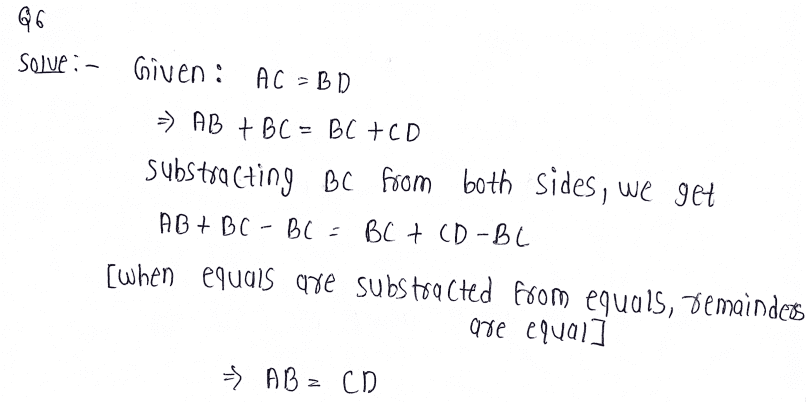NCERT Class 9 Maths Solutions PDF: In this post, we have discussed the solution of the Maths class 9 book which is followed in all CBSE schools. Solutions are given below with proper Explanation and utmost care has been taken to ensure that the solutions are correct. Answers provided will not only help in completing all the assignments but also help students in clearing their concepts. Students can download the solutions by printing the chapters by using the command Ctrl+P in google chrome and saving it in PDF format. All the best !! Please support us by sharing this website with your school friends.
Exercise 5.1 Class 9 Maths Chapter 5 Introduction to Euclid’s Geometry
1. Which of the following statements are true and which are false? Give reasons for your answers.
(i) Only one line can pass through a single point.
(ii) There are an infinite number of lines which pass through two distinct points.
(iii) A terminated line can be produced indefinitely on both the sides.
(iv) If two circles are equal, then their radii are equal.
(v) In Fig. 5.9, if AB = PQ and PQ = XY, then AB = XY.


2. Give a definition for each of the following terms. Are there other terms that need to be defined first? What are they, and how might you define them?
(i) parallel lines (ii) perpendicular lines (iii) line segment (iv) radius of a circle (v) square


3. Consider two ‘postulates’ given below:
(i) Given any two distinct points A and B, there exists a third point C which is in between A and B.
(ii) There exist at least three points that are not on the same line.
Do these postulates contain any undefined terms? Are these postulates consistent? Do they follow from Euclid’s postulates? Explain.
Solution 3:
Yes, these postulates contain undefined terms. Undefined terms in the postulates are:
– There are many points that lie in a plane. But, in the postulates given here, the position of the point C is not given, as of whether it lies on the line segment joining AB or not.
– On top of that, there is no information about whether the points are in same plane or not.
And
Yes, these postulates are consistent when we deal with these two situations:
– Point C is lying on the line segment AB in between A and B.
– Point C does not lie on the line segment AB.
No, they don’t follow from Euclid’s postulates. They follow the axioms.
4. If a point C lies between two points A and B such that AC = BC, then prove that AC = 1/2 AB. Explain by drawing the figure.
Solution 4:

Given that, AC = BC
Now, adding AC both sides.
L.H.S+AC = R.H.S+AC
AC+AC = BC+AC
2AC = BC+AC
We know that, BC+AC = AB (as it coincides with line segment AB)
∴ 2 AC = AB (If equals are added to equals, the wholes are equal.)
⇒ AC = (½)AB.
5. In Question 4, point C is called a mid-point of line segment AB. Prove that every line segment has one and only one mid-point.

6. In Fig. 5.10, if AC = BD, then prove that AB = CD.


7. Why is Axiom 5, in the list of Euclid’s axioms, considered a ‘universal truth’? (Note that the question is not about the fifth postulate.)

1 thought on “NCERT Solutions | Class 9 Maths Chapter 5 Introduction to Euclid’s Geometry”